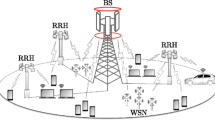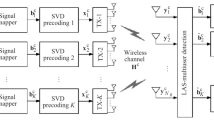Abstract
The large scale multiuser multiple input multiple output (MU-MIMO) is one of the promising communication technology for 5G wireless networks as it offers reliability, high spectral efficiency and high throughput. The lattice reduction (LR) precoding based user level local likelihood ascent search (ULAS) detection scheme is proposed in this paper for efficient signal detection in large scale MU-MIMO system. The initial solution of ULAS algorithm is obtained from the LR precoding assisted zero forcing detector. The LR precoding transforms the non-orthogonal channel matrix into nearly orthogonal channel, which helps to mitigate inter antenna interference (IAI) exists at each user. The remaining multiuser interference (MUI) imposed to each user from undesired users is cancelled by the proposed ULAS multiuser detection scheme. Thus, the proposed LR precoding assisted ULAS mitigates both IAI and MUI unlike the classical detector, those try to moderate either IAI or MUI. By contrast, the proposed ULAS detector provides performance close to optimal maximum likelihood detector with just a fraction of its complexity.









Similar content being viewed by others
References
Balaji, S., Nathani, K., & Santhakumar, R. (2019). IoT technology, applications and challenges: A contemporary survey. Wireless Personal Communications, 108, 363–388.
Awoyemi, B. S., Alfa, A. S., & Maharaj, B. T. J. (2020). Resource optimisation in 5G and internet-of-things networking. Wireless Personal Communications, 111, 2671–2702.
Goudos, S. K., Dallas, P. I., Chatziefthymiou, S., et al. (2017). A survey of IoT key enabling and future technologies: 5G, mobile IoT, sematic web and applications. Wireless Personal Communications, 97, 1645–1675.
Kuhlins, C., Rathonyi, B., Zaidi, A., Hogan, M. (2020). Cellular networks for Massive IoT. Ericsson. https://www.ericsson.com/48ff1f/assets/local/reports-papers/white-papers/massive_iot_whitepaper.pdf. Accessed January 2020.
Fu, S., Su, Z., Jia, Y., Zhou, H., Jin, Y., Ren, J., Wu, B., & Huq, K. M. S. (2017). Interference cooperation via distributed game in 5G networks. IEEE Internet of Things, 6(1), 311–320.
Kim, T., & Kim, E. (2018). Uplink scheduling of MU-MIMO gateway for massive data acquisition in Internet of things. The Journal of Supercomputing, 74, 3549–3563.
Chockalingam, A., & Rajan, B. S. (2014). Large MIMO systems. Cambridge: Cambridge University Press.
Agiwal, M., Saxena, N., & Roy, A. (2018). Ten commandments of emerging 5G networks. Wireless Personal Communications, 98, 2591–2621.
Panwara, N., Sharma, S., & Singh, A. K. (2016). A survey on 5G: The next generation of mobile communication. Physical Communications, 18, 64–84.
Selvaraj, K., Judson, D., Ganeshkumar, P., et al. (2020). Low complexity linear detection for uplink multiuser MIMO SC-FDMA systems. Wireless Personal Communications, 112, 631–649.
Fatema, N., Hua, G., Xiang, Y., Peng, D., & Natgunanathan, I. (2017). Massive MIMO linear precoding: A survey. IEEE Systems Journal, 12(4), 3920–3931.
Lee, D. (2015). Performance analysis of zero-forcing precoded scheduling system with adaptive modulation for multiuser-multiple input multiple output transmission. IET Communications, 9(16), 2007–2012.
He, X., Guo, Q., Tong, J., Xi, J., & Yu, Y. (2017). Low-complexity approximate iterative LMMSE detection for large-scale MIMO systems. Digital Sign Processing, 60, 134–139.
Challa, N. R., & Bagadi, K. (2020). Design of massive multiuser MIMO system to mitigate inter antenna interference and multiuser interference in 5G wireless networks. Journal of Communications, 15(9), 693–701. https://doi.org/10.12720/jcm.15.9.693-701
Riadi, A., Boulouird, M., & Hassani, M. M. (2021). ZF and MMSE detectors performances of a massive MIMO system combined with OFDM and M-QAM modulation. Wireless Personal Communications, 116, 3261–3276. https://doi.org/10.1007/s11277-020-07848-4
Parikh, J., & Basu, A. (2020). Technologies assisting the paradigm shift from 4G to 5G. Wireless Personal Communications, 112, 481–502. https://doi.org/10.1007/s11277-020-07053-3
Challa, N. R., & Bagadi, K. (2020). Likelihood ascent search detection for coded massive MU-MIMO systems to mitigate IAI and MUI. Radioelectronics and Communications Systems, 63(5), 223–234. https://doi.org/10.3103/S0735272720050015
Casal, P. S., Coma, J. P. G., Fresnedo, O., & Castedo, L. (2018). Design of linear precoders for correlated sources in MIMO multiple access channels. IEEE Transactions on Communications, 68(12), 6110–6122.
Challa, N. R., & Bagadi, K. (2020). Design of near-optimal local likelihood search-based detection algorithm for coded large-scale MU-MIMO system. International Journal of Communication Systems. https://doi.org/10.1002/dac.4436
Jagannatham, A. K. (2017). Principles of modern wireless communication systems. New Delhi: McGraw Hill.
Zhang, W., Zhang, Z., Qi, L., & Dou, Z. (2019). Lattice-reduction-aided signal detection in spatial multiplexing MIMO–GFDM systems. Physical Communication, 33, 71–77.
Ouni, N., Tourki, K., Mohaisen, M., & Bouallegue, R. (2019). Reduced complexity lattice-based multiple-input multiple-output schemes. IET Communications, 13(10), 1472–1481.
Chen, C. E., & Sheen, W. H. (2013). Design of lattice reduction algorithms for linear-precoded MIMO system. IEEE Wireless Communications Letters, 3(1), 46–49.
Fang, S., Wu, J., Lu, C., Yue, Z. D., & Han, Y. C. (2016). Simplified QR-decomposition based and lattice reduction-assisted multi-user multiple-input–multiple-output precoding scheme. IET Communications, 10(5), 586–593.
Lyu, S., & Ling, C. (2018). Hybrid vector perturbation precoding: The blessing of approximate message passing. IEEE Transactions on Signal Processing, 67(1), 178–193.
Lenin Gopal, L., Rong, Y., & Zang, Z. (2015). Tomlinson-Harashima precoding based transceiver design for MIMO relay systems with channel covariance information. IEEE Transactions on Wireless Communications, 14(10), 5513–5525.
Wübben, D., Seethaler, D., Jaldén, J., & Matz, G. (2011). Lattice reduction. IEEE Signal Processing Magazine, 28(3), 70–91.
Wen, Q., & Ma, X. (2016). Efficient greedy LLL algorithms for lattice decoding. IEEE Transactions on Wireless Communications, 15(5), 356–3572.
Menon, U. V., Challa, N. R., & Bagadi, K. (2019). Lenstra Lenstra Lovász (LLL) assisted likelihood ascent search (LAS) algorithm for signal detection in massive MIMO. In Proceedings of international conference on vision towards emerging trends in communication and networking. https://doi.org/10.1109/ViTECoN.2019.8899594
Nguyen, T. B., Le, M. T., & Ngo, V. D. (2019). Low complexity lattice reduction aided detectors for high load massive MIMO systems. Wireless Personal Communications, 109, 1805–1825. https://doi.org/10.1007/s11277-019-06653-y
Mussi, A. M., Costa, B. F., & Abrão, T. (2017). Efficient lattice reduction aided detectors under realistic MIMO channels. Wireless Personal Communications, 95, 947–978. https://doi.org/10.1007/s11277-016-3807-6
Yang, Y., & Kim, J. (2013). Fixed-complexity LLL-based signal detection for MIMO systems. IEEE Transactions on Vehicular Technology, 62(3), 1415–1419.
Bagadi, K. P., Annepu, V., & Das, S. (2016). Recent trends in multiuser detection techniques for SDMA–OFDM communication system. Physical Communications, 20, 93–108.
Albreem, M. A., Juntti, M., & Shahabuddin, S. (2019). Massive MIMO detection techniques: A survey. IEEE Communications Surveys and Tutorials, 21(4), 3109–3132.
Challa, N. R., & Bagadi, K. (2018). Lattice reduction assisted likelihood ascent search algorithm for multiuser detection in massive MIMO system. Proceedings of IEEE India Council International Conference. https://doi.org/10.1109/INDICON45594.2018.8987139
Gudla, V. V., & Kumaravelu, V. B. (2019). Dynamic spatial modulation for next generation networks. Physical Communications, 34, 90–104.
Pan, S., & Chen, P. (2021). User selection in MU-MIMO system with limited CSI feedback. Wireless Personal Communications. https://doi.org/10.1007/s11277-020-08020-8
Kansal, L., Sharma, V., & Singh, J. (2019). Multiuser massive MIMO-OFDM system incorporated with diverse transformation for 5G applications. Wireless Personal Communications, 109, 2741–2756. https://doi.org/10.1007/s11277-019-06707-1
Li, L., Meng, W., & Li, C. (2017). Semidefinite further relaxation on likelihood ascent search detection algorithm for high-order modulation in massive MIMO system. IET Communications, 11(6), 801–808.
Chaudhary, M., Meena, N. K., & Kshetrimayum, R. S. (2017). Local search based near optimal low complexity detection for large MIMO System. In Proceedings of IEEE international conference on advanced networks and telecommunications systems. https://doi.org/10.1109/ANTS.2016.7947792.
Chihaoui, I., & Ammari, M. L. (2019). LAS detector with soft-output MMSE initialization under imperfect channel estimation and channel correlation. Wireless Personal Communications, 108, 213–220. https://doi.org/10.1007/s11277-019-06397-9
Agarwal, S., Sah, A. K., & Chaturvedi, A. K. (2017). Likelihood-based tree search for low complexity detection in large MIMO systems. IEEE Wireless Communications Letters, 6(4), 450–453.
Albataineh, Z. (2021). Low-complexity near-optimal iterative signal detection based on MSD-CG method for uplink massive MIMO systems. Wireless Personal Communications, 116, 2549–2563. https://doi.org/10.1007/s11277-020-07810-4
Author information
Authors and Affiliations
Corresponding author
Additional information
Publisher's Note
Springer Nature remains neutral with regard to jurisdictional claims in published maps and institutional affiliations.
Rights and permissions
About this article
Cite this article
Challa, N.R., Bagadi, K. Design of Large Scale MU-MIMO System with Joint Precoding and Detection Schemes for Beyond 5G Wireless Networks. Wireless Pers Commun 121, 1627–1646 (2021). https://doi.org/10.1007/s11277-021-08688-6
Accepted:
Published:
Issue Date:
DOI: https://doi.org/10.1007/s11277-021-08688-6




